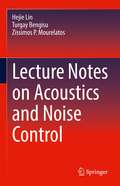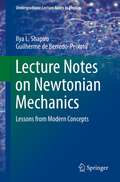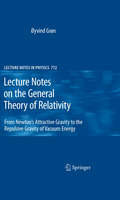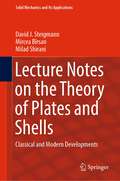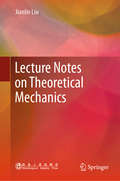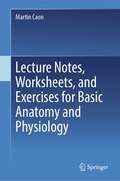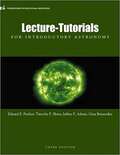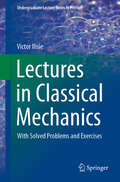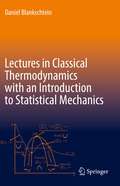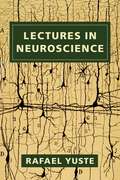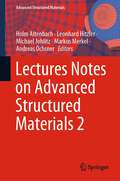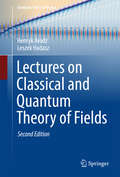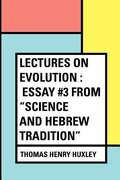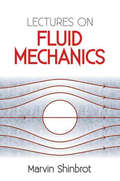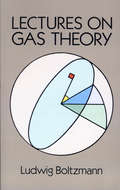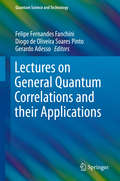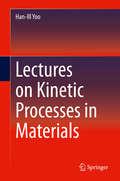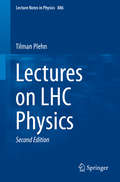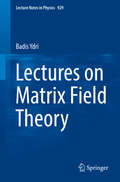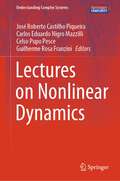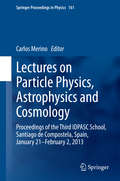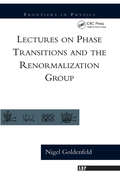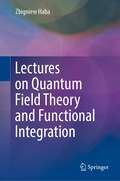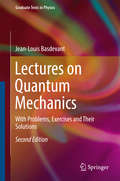- Table View
- List View
Lecture Notes on Acoustics and Noise Control
by Zissimos P. Mourelatos Hejie Lin Turgay BengisuThis textbook provides a guide to the fundamental principles of acoustics in a straightforward manner using a solid foundation in mathematics and physics. It is designed for those who are new to acoustics and noise control, and includes all the necessary material for a comprehensive understanding of the topic. It is written in lecture-note style and can be easily adapted to an acoustics-related one semester course at the senior undergraduate or graduate level. The book also serves as a ready reference for the practicing engineer new to the application of acoustic principles arising in product design and fabrication.
Lecture Notes on Newtonian Mechanics: Lessons from Modern Concepts
by Guilherme de Berredo-Peixoto Ilya L. ShapiroOne could make the claim that all branches of physics are basically generalizations of classical mechanics. It is also often the first course which is taught to physics students. The approach of this book is to construct an intermediate discipline between general courses of physics and analytical mechanics, using more sophisticated mathematical tools. The aim of this book is to prepare a self-consistent and compact text that is very useful for teachers as well as for independent study.
Lecture Notes on the General Theory of Relativity
by Øyvind GrønThis book is the result of more than twenty years of lecturing a master course on the General Theory of Relativity at the University of Oslo, Norway, by Dr. Øyvind Grøn. The text has been continuously updated by Dr. Grøn and is written so students can follow the deductions all the way throughout the book. The conceptual content of the general theory of relativity is presented briefly but reasonably and completely. Both bachelor students and master students will find the text useful as the manuscript is organized to easily find the topics one wants to read about, with separate lists of contents, figures, definitions, examples, and an index.
Lecture Notes on the Theory of Plates and Shells: Classical and Modern Developments (Solid Mechanics and Its Applications #274)
by David J. Steigmann Mircea Bîrsan Milad ShiraniThis book presents the theory of plates and shells on the basis of the three-dimensional parent theory. The authors explore the thinness of the structure to represent the mechanics of the actual thin three-dimensional body under consideration by a more tractable two-dimensional theory associated with an interior surface. In this way, the relatively complex three-dimensional continuum mechanics of the thin body is replaced by a far more tractable two-dimensional theory. To ensure that the resulting model is predictive, it is necessary to compensate for this ‘dimension reduction’ by assigning additional kinematical and dynamical descriptors to the surface whose deformations are modelled by the simpler two-dimensional theory. The authors avoid the various ad hoc assumptions made in the historical development of the subject, most notably the classical Kirchhoff–Love hypothesis requiring that material lines initially normal to the shell surface remain so after deformation. Instead, such conditions, when appropriate, are here derived rather than postulated.
Lecture Notes on Theoretical Mechanics
by Jianlin LiuThis book addresses a range of basic and essential topics, selected from the author's teaching and research activities, offering a comprehensive guide in three parts: Statics, Kinematics and Kinetics. Chapter 1 briefly discusses the history of classical and modern mechanics, while Chapter 2, presents preliminary knowledge, preparing readers for the subsequent chapters. Chapters 3 to 7 introduce statics, force analysis, simplification of force groups, equilibrium of the general coplanar force group, and the center of the parallel force group. The Kinematics section (Chapters 8 to 10), covers the motion of a particle, basic motion and planar motion of a rigid body.Lastly, the Kinetics section (Chapters 11 to 14) explores Newton’s law of motion, theorem of momentum, theorem of angular momentum, and theorem of kinetic energy. With numerous examples from engineering, illustrations, and step-by-step tutorials, the book is suitable for both classroom use and self-study. After completing the course, students will be able to simplify complex engineering structures and perform force and motion analyses on particles and structures, preparing them for further study and research. The book can be used as a textbook for undergraduate courses on fundamental aspects of theoretical mechanics, such as aerospace, mechanical engineering, petroleum engineering, automotive and civil engineering, as well as material science and engineering.
Lecture Notes, Worksheets, and Exercises for Basic Anatomy and Physiology
by Martin CaonThis volume contains twenty-six lectures on basic anatomy and physiology for first-year university students. Topics included are standard for anatomy and physiology courses, including cells and tissues, a brief review of chemistry, thermoregulation and homeostasis, the musculo-skeletal system, structure and function of blood vessels, respiration, the reproductive system, and more.Also included are sixteen worksheets with homework exercises that complement the lectures. Suggested answers to all the worksheets are also included at the end of the book.This is an ideal book for professors teaching basic anatomy and physiology courses as well as researchers, students, and professionals looking to brush up on the subject. The book complements the already published, Martin Caon (2020) “Examination Questions and Answers in Basic Anatomy and physiology: 2900 Multiple Choice Questions and 64 Essay Topics. 3rd Ed.” Springer ISBN 978-3-030-47313-6
Lecture-Tutorials for Introductory Astronomy
by Jeff Adams Gina Brissenden Edward Prather Tim SlaterLecture-Tutorials for Introductory Astronomy provides a collection of 44 collaborative learning, inquiry-based activities to be used with introductory astronomy courses. Based on education research, these activities are “classroom ready” and lead to deeper, more complete understanding through a series of structured questions that prompt you to use reasoning and identify and correct their misconceptions. All content has been extensively field tested and six new tutorials have been added that respond to reviewer demand, numerous interviews, and nationally conducted workshops.
Lectures in Classical Mechanics: With Solved Problems and Exercises (Undergraduate Lecture Notes in Physics)
by Victor IlisieThis exceptionally well-organized book uses solved problems and exercises to help readers understand the underlying concepts of classical mechanics; accordingly, many of the exercises included are of a conceptual rather than practical nature. A minimum of necessary background theory is presented, before readers are asked to solve the theoretical exercises. In this way, readers are effectively invited to discover concepts on their own. While more practical exercises are also included, they are always designed to introduce readers to something conceptually new. Special emphasis is placed on important but often-neglected concepts such as symmetries and invariance, especially when introducing vector analysis in Cartesian and curvilinear coordinates. More difficult concepts, including non-inertial reference frames, rigid body motion, variable mass systems, basic tensorial algebra, and calculus, are covered in detail. The equations of motion in non-inertial reference systems are derived in two independent ways, and alternative deductions of the equations of motion for variable mass problems are presented. Lagrangian and Hamiltonian formulations of mechanics are studied for non-relativistic cases, and further concepts such as inertial reference frames and the equivalence principle are introduced and elaborated on.
Lectures in Classical Thermodynamics with an Introduction to Statistical Mechanics
by Daniel BlankschteinThis textbook facilitates students’ ability to apply fundamental principles and concepts in classical thermodynamics to solve challenging problems relevant to industry and everyday life. It also introduces the reader to the fundamentals of statistical mechanics, including understanding how the microscopic properties of atoms and molecules, and their associated intermolecular interactions, can be accounted for to calculate various average properties of macroscopic systems. The author emphasizes application of the fundamental principles outlined above to the calculation of a variety of thermodynamic properties, to the estimation of conversion efficiencies for work production by heat interactions, and to the solution of practical thermodynamic problems related to the behavior of non-ideal pure fluids and fluid mixtures, including phase equilibria and chemical reaction equilibria. The book contains detailed solutions to many challenging sample problems in classical thermodynamics and statistical mechanics that will help the reader crystallize the material taught. Class-tested and perfected over 30 years of use by nine-time Best Teaching Award recipient Professor Daniel Blankschtein of the Department of Chemical Engineering at MIT, the book is ideal for students of Chemical and Mechanical Engineering, Chemistry, and Materials Science, who will benefit greatly from in-depth discussions and pedagogical explanations of key concepts. Distills critical concepts, methods, and applications from leading full-length textbooks, along with the author’s own deep understanding of the material taught, into a concise yet rigorous graduate and advanced undergraduate text;Enriches the standard curriculum with succinct, problem-based learning strategies derived from the content of 50 lectures given over the years in the Department of Chemical Engineering at MIT;Reinforces concepts covered with detailed solutions to illuminating and challenging homework problems.
Lectures in Neuroscience
by Rafael YusteThe human brain is perhaps the most intricate and fascinating object in the known universe. Through a mysterious process, the activity of billions of neurons within a few pounds of matter generates the unfathomable complexity of the mind.This book is a conversational and accessible introduction to the brain. Beginning from basic elements of neuroscience, the acclaimed scientist Rafael Yuste guides readers through increasingly sophisticated topics, developing a unified framework for how the brain functions. He describes how the brain is organized and how it develops, how neurons operate and form neural circuits, and how these circuits function as neural networks to generate behavior and mental states.Yuste challenges the traditional view that the brain is an input-output machine that reacts reflexively to sensory stimuli. Instead, he argues, the purpose of the brain is to make a predictive model of the world in order to anticipate the future and choose successful courses of action. He gives readers insight into the workings of sensory and motor systems and the neurobiological basis of our perceptions, thoughts, emotions, memories, and consciousness.Peppered with anecdotes and illustrated with elegant drawings and diagrams, this succinct and cohesive book is accessible to readers without previous background in the subject. It is written for anyone seeking to grasp the core principles of neuroscience or looking for a fresh and clear perspective on how the brain works.
Lectures Notes on Advanced Structured Materials 2 (Advanced Structured Materials #203)
by Holm Altenbach Leonhard Hitzler Michael Johlitz Markus Merkel Andreas ÖchsnerThe postgraduate seminar series on advanced structured materials is designed to facilitate teaching and informal discussion in a supportive and friendly environment. The seminar provides a forum for postgraduate students to present their research results and train their presentation and discussion skills. Furthermore, it allows for extensive discussion of current research being conducted in the wider area of advanced structured materials. Doing so, it builds a wider postgraduate community and offers networking opportunities for early career researchers. In addition to focused lectures, the seminar provides specialized teaching/overview lectures from experienced senior academics. The 2023 Postgraduate Seminar entitled “Advanced Structured Materials: Development - Manufacturing - Characterization – Applications” was held from 20th till 24th February 2023 in Barcelona. The presented postgraduate lectures had a strong focus on polymer mechanics, composite materials, and additive manufacturing.
Lectures on Astrophysics
by Steven WeinbergLectures on Astrophysics provides an account of classic and contemporary aspects of astrophysics, with an emphasis on analytic calculations and physical understanding. It introduces fundamental topics in astrophysics, including the properties of single and binary stars, the phenomena associated with interstellar matter, and the structure of galaxies. Nobel Laureate Steven Weinberg combines exceptional physical insight with his gift for clear exposition to cover exciting recent developments and new results. Emphasizing theoretical results, and explaining their derivation and application, this book provides an invaluable resource for physics and astronomy students and researchers.
Lectures on Classical and Quantum Theory of Fields
by Henryk Arodz Leszek HadaszThis textbook on classical and quantum theory of fields addresses graduate students starting to specialize in theoretical physics. It provides didactic introductions to the main topics in the theory of fields, while taking into account the contemporary view of the subject. The student will find concise explanations of basic notions essential for applications of the theory of fields as well as for frontier research in theoretical physics. One third of the book is devoted to classical fields. Each chapter contains exercises of varying degree of difficulty with hints or solutions, plus summaries and worked examples as useful. The textbook is based on lectures delivered to students of theoretical physics at Jagiellonian University. It aims to deliver a unique combination of classical and quantum field theory in one compact course.
Lectures on Evolution
by Thomas Henry HuxleyThomas Henry Huxley was popularly known as "Darwin's Bulldog," and that's because the 19th century scientist was a forceful advocate for Darwin's theory of evolution. Huxley himself also wrote at length on the topic.
Lectures on Fluid Mechanics (Dover Books on Physics)
by Marvin ShinbrotA readable and user-friendly introduction to fluid mechanics, this high-level text is geared toward advanced undergraduates and graduate students. Topics include a derivation of the equations of fluid motion from statistical mechanics, classical theory, and a portion of the modern mathematical theory of viscous, incompressible fluids, with considerable attention to the Navier-Stokes equations. 1973 edition.
Lectures on Gas Theory (Dover Books On Physics Series)
by Ludwig BoltzmannOne of the great masterpieces of theoretical physics, this classic work contains a comprehensive exposition of the kinetic theory of gases that is still relevant today, nearly 100 years after its first publication. Although the modifications of quantum mechanics have rendered some parts of the work obsolete, many of the topics dealt with still yield to the classical-mechanics approach outlined by Boltzmann; moreover, a variety of problems in aerodynamics, nuclear reactors, and thermonuclear power generation are best solved by Boltzmann's famous transport equation.The work is divided into two parts: Part I deals with the theory of gases with monatomic particles, whose dimensions are negligible compared to the mean free path. Topics include molecules as elastic spheres and as centers of force, external forces and visible motions of the gas and the repelling force between molecules. Part II covers van der Waals' theory, the principles of general mechanics needed for a gas theory, gases with compound molecules, derivation of van der Waals' equation by means of the virial concept, theory of dissociation and supplements to the laws of thermal equilibrium in gases with compound molecules.Combining rigorous mathematical analysis with pragmatic treatment of physical and chemical applications, Lectures on Gas Theory was the standard work on kinetic theory in the first quarter of the 20th century.
Lectures on General Quantum Correlations and their Applications
by Felipe Fernandes Fanchini Diogo de Oliveira Soares Pinto Gerardo AdessoThis book presents a distinctive way of understanding quantum correlations beyond entanglement, introducing readers to this less explored yet very fundamental aspect of quantum theory. It takes into account most of the new ideas involving quantum phenomena, resources, and applications without entanglement, both from a theoretical and an experimental point of view. This book serves as a reference for both beginner students and experienced researchers in physics and applied mathematics, with an interest in joining this novel venture towards understanding the quantum nature of the world.
Lectures on Kinetic Processes in Materials
by Han-Ill YooThis book provides beginning graduate or senior-level undergraduate students in materials disciplines with a primer of the fundamental and quantitative ideas on kinetic processes in solid materials. Kinetics is concerned with the rate of change of the state of existence of a material system under thermodynamic driving forces. Kinetic processes in materials typically involve chemical reactions and solid state diffusion in parallel or in tandem. Thus, mathematics of diffusion in continuum is first dealt with in some depth, followed by the atomic theory of diffusion and a brief review of chemical reaction kinetics. Chemical diffusion in metals and ionic solids, diffusion-controlled kinetics of phase transformations, and kinetics of gas-solid reactions are examined. Through this course of learning, a student will become able to predict quantitatively how fast a kinetic process takes place, to understand the inner workings of the process, and to design the optimal process of material state change.Provides students with the tools to predict quantitatively how fast a kinetic process takes place and solve other diffusion related problems;Learns fundamental and quantitative ideas on kinetic processes in solid materials;Examines chemical diffusion in metals and ionic solids, diffusion-controlled kinetics of phase transformations, and kinetics of gas-solid reactions, among others;Contains end-of chapter exercise problems to help reinforce students' grasp of the concepts presented within each chapter.
Lectures on LHC Physics
by Tilman PlehnWhen trying to apply the solid knowledge of quantum field theory to actual LHC physics - in particular to the Higgs sector and certain regimes of QCD - one inevitably meets an intricate maze of phenomenological know-how, common lores and other, often historically grown intuition about what works and what not. These lectures are intended to be a brief but sufficiently detailed primer on LHC physics that will enable graduate students and any newcomer to the field to find their way through the more advanced literature as well as helping them to start work in this very timely and exciting field of research.
Lectures on Matrix Field Theory
by Badis YdriThese lecture notes provide a systematic introduction to matrix models of quantum field theories with non-commutative and fuzzy geometries. The book initially focuses on the matrix formulation of non-commutative and fuzzy spaces, followed by a description of the non-perturbative treatment of the corresponding field theories. As an example, the phase structure of non-commutative phi-four theory is treated in great detail, with a separate chapter on the multitrace approach. The last chapter offers a general introduction to non-commutative gauge theories, while two appendices round out the text. Primarily written as a self-study guide for postgraduate students - with the aim of pedagogically introducing them to key analytical and numerical tools, as well as useful physical models in applications - these lecture notes will also benefit experienced researchers by providing a reference guide to the fundamentals of non-commutative field theory with an emphasis on matrix models and fuzzy geometries.
Lectures on Nonlinear Dynamics (Understanding Complex Systems)
by José Roberto Castilho Piqueira Carlos Eduardo Nigro Mazzilli Celso Pupo Pesce Guilherme Rosa FranziniThis book presents a compilation of lectures delivered at the São Paulo School of Advanced Sciences on Nonlinear Dynamics, categorized into four groups: parametric resonance, nonlinear modal analysis and model reduction, synchronization, and strongly nonlinear dynamics. Interwoven seamlessly, these groups cover a wide range of topics, from fundamental concepts to practical applications, catering to both introductory and advanced readers. The first group, consisting of chapters 1 and 2, serves as an introduction to the theory of parametric resonance and the dynamics of parametrically excited slender structures. Chapters 3, 4, and 5 form the second group, offering insights into normal forms, nonlinear normal modes, and nonlinear system identification. Chapters 6 and 7 delve into asynchronous modes of structural vibration and master-slave topologies for time signal distribution within synchronous systems, respectively, representing the third group. Finally, the last four chapters tackle the fourth group, exploring nonlinear dynamics of variable mass oscillators, advanced analytical methods for strong nonlinear vibration problems, chaos theory, and dynamic integrity from the perspectives of safety and design. This book harmoniously combines theoretical depth and practical relevance to provide a comprehensive understanding of nonlinear dynamics.
Lectures on Particle Physics, Astrophysics and Cosmology
by Carlos MerinoThis volume gathers the content of the courses held at the Third IDPASC School, which took place in San Martiño Pinario, Hospederia and Seminario Maior, in the city of Santiago de Compostela, Galiza, Spain, from January 21st to February 2nd, 2013. This school is the annual joint program of the International Doctorate Network in Particle Physics, Astrophysics, and Cosmology (IDPASC). The purpose of the school series is to present doctoral students from different universities and laboratories in Europe and beyond with a broad range of the latest results and current state of the art in the fields of Particle Physics, Astrophysics, and Cosmology, and to further introduce them to both the questions now posed by the potentials of physics and to challenges connected with current and future experiments - in particular, with the newly available energy ranges. Following these guidelines, the content of this third edition of the IDPASC School was jointly planned by the Academic Council and by the network's International Committee, whose members ensure every year its timely formulation, keeping up with the constant evolution of these fields. The program covers a balanced range of the latest developments in these fields worldwide, with courses offered by internationally acknowledged physicists on the Basic Features of Hadronic Processes, Quantum Chromodynamics, Physics and Technology of ALICE, LHCb Physics-Parity Violation, the Higgs System in and beyond the Standard Model, Higgs Searches at the LHC, Theory and Experiments with Cosmic Rays, Numerical Methods and Data Analysis in Particle Physics, Theoretical Cosmology, and AdS/CFT Correspondence. Most of these courses were complemented by practical and discussion sessions.
Lectures On Phase Transitions And The Renormalization Group
by Nigel GoldenfeldCovering the elementary aspects of the physics of phases transitions and the renormalization group, this popular book is widely used both for core graduate statistical mechanics courses as well as for more specialized courses. Emphasizing understanding and clarity rather than technical manipulation, these lectures de-mystify the subject and show precisely "how things work." Goldenfeld keeps in mind a reader who wants to understand why things are done, what the results are, and what in principle can go wrong. The book reaches both experimentalists and theorists, students and even active researchers, and assumes only a prior knowledge of statistical mechanics at the introductory graduate level.Advanced, never-before-printed topics on the applications of renormalization group far from equilibrium and to partial differential equations add to the uniqueness of this book.
Lectures on Quantum Field Theory and Functional Integration
by Zbigniew HabaThis book offers a concise introduction to quantum field theory and functional integration for students of physics and mathematics. Its aim is to explain mathematical methods developed in the 1970s and 1980s and apply these methods to standard models of quantum field theory. In contrast to other textbooks on quantum field theory, this book treats functional integration as a rigorous mathematical tool. More emphasis is placed on the mathematical framework as opposed to applications to particle physics. It is stressed that the functional integral approach, unlike the operator framework, is suitable for numerical simulations. The book arose from the author's teaching in Wroclaw and preserves the form of his lectures. So some topics are treated as an introduction to the problem rather than a complete solution with all details. Some of the mathematical methods described in the book resulted from the author's own research.
Lectures on Quantum Mechanics
by Jean-Louis BasdevantBeautifully illustrated and engagingly written, Twelve Lectures in Quantum Mechanics presents theoretical physics with a breathtaking array of examples and anecdotes. Basdevant's style is clear and stimulating, in the manner of a brisk lecture that can be followed with ease and enjoyment. Here is a sample of the book's style, from the opening of Chapter 1: "If one were to ask a passer-by to quote a great formula of physics, chances are that the answer would be 'E = mc2'. . . . There is no way around it: all physics is quantum, from elementary particles, to stellar physics and the Big Bang, not to mention semiconductors and solar cells. "
